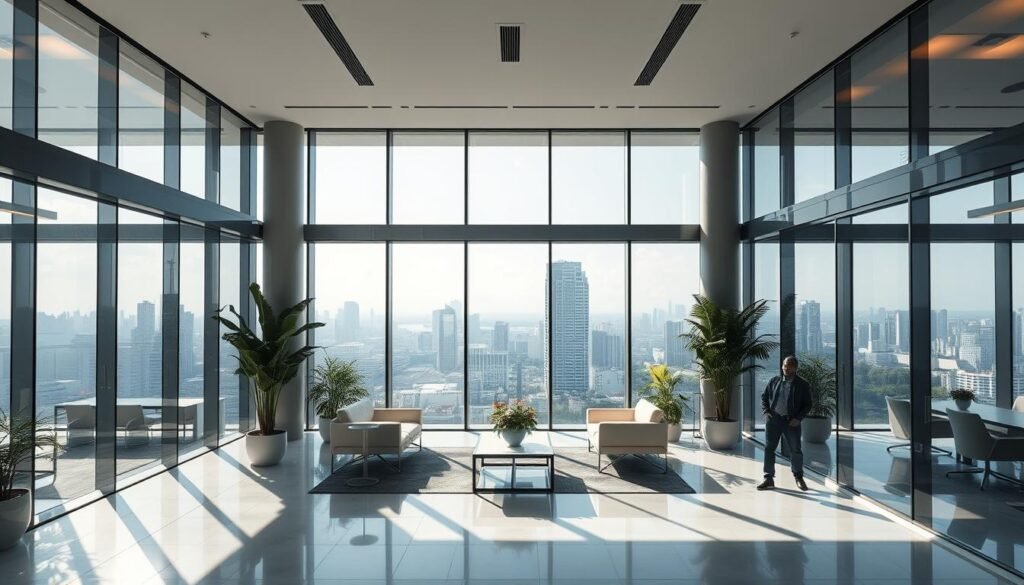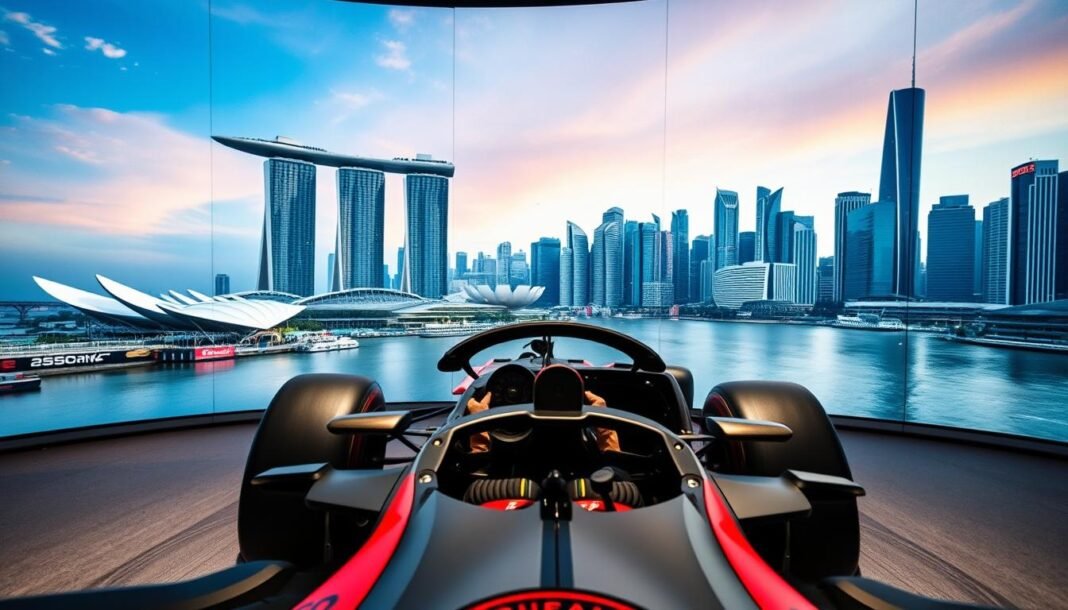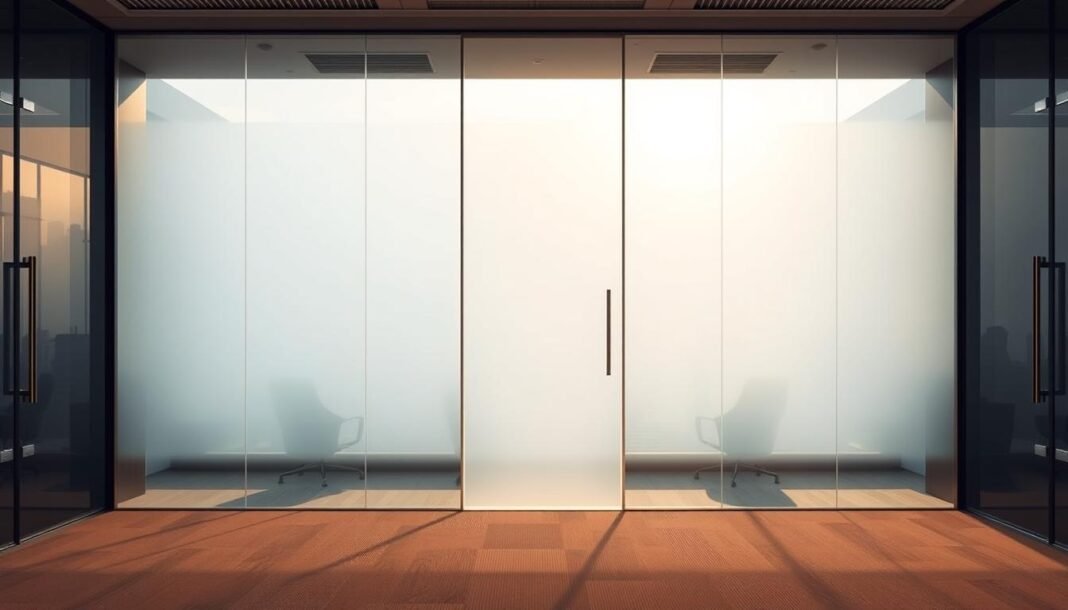Electrochromic glass, or smart-tinting glass, is changing Singapore’s buildings. It was tested at Nanyang Technological University’s ERI@N at BCA SkyLab. This shows how it beats regular windows.
Halio’s electrochromic panels block glare fully. They keep rooms 95% comfortable and cut energy use by 25%. Imagine buildings like Marina Bay Sands with glass that changes color automatically. It’s style and saving energy together.
Smart glass singapore is more than a trend—it’s a solution. It’s better than old windows with blinds. It changes with sunlight, saving energy and making rooms more comfortable.
It’s used in office buildings and homes. This tech combines new design with green goals. Projects like MBFC Tower show how it can change spaces without losing beauty. It’s the future of buildings that change, adapt, and stay cool.
Key Takeaways
- Smart glass singapore reduces glare 100% and lowers energy use by up to 25%.
- Electrochromic tech maintains 95% thermal comfort, outperforming traditional windows.
- Buildings like Marina Bay Sands use smart glass singapore to balance views and climate control.
- Halio’s studies prove electrochromic glass cuts lighting energy by 17–25%.
- Smart-tinting options like Nexus S-Shadelite offer customizable light control and energy savings.
Introduction to Electrochromic Glass
Electrochromic glass is a smart material that changes spaces in Singapore. It’s different from regular windows because it can change tint with electricity. This energy efficient glass meets various needs, making it perfect for modern buildings.
What is Electrochromic Glass?
Electrochromic glass has a thin layer that changes from clear to tinted with electricity. When voltage is applied, ions move, making it darker or lighter. It’s different from other types like photochromic or SPD glass. Its benefits include:
- Adjustable light transmission
- Reduces glare and heat
- Saves energy by cutting AC use
History and Evolution
Research on electrochromic glass started in the 1960s. By the 1990s, prototypes were ready for cars and buildings. Today, it’s in famous places like the Marina Bay Sands. Key moments include:
- 1960s: First electrochromic compounds discovered
- 1990s: First commercial products launched
- 2020s: Smart integration with IoT systems
From lab to high-rise, energy efficient glass is changing building design in Singapore’s climate.
How Electrochromic Glass Works
Electrochromic glass changes spaces by mixing light and privacy with smart tech. Here’s how it works:
Mechanism of Light Control
Privacy glass singapore has a thin electrochromic layer between glass panes. A small electrical charge starts a chemical reaction. This changes the material’s opacity.
Users can switch between clear and frosted views with a button or app.
- Transparent mode: Voltage off → glass becomes clear
- Opaque mode: Voltage on → ions shift to block light
- Customizable tint levels: Adjusts based on sunlight or user preference
Integration with Modern Design
Architects in Singapore use electrochromic glass in buildings. It improves looks and function. Here’s how it compares to old ways:
| Feature | Traditional Windows | Electrochromic Glass |
|---|---|---|
| Light Control | Manual blinds or shades | Automated, instant adjustments |
| Privacy Options | Permanent partitions | Instant switch between transparent/opaque |
| Design Flexibility | Restricted by fixed materials | Seamless into sleek, minimalist frameworks |
From office walls to homes, privacy glass singapore systems work with smart home tech. They change spaces easily. This innovation shows how glass can be both useful and stylish for modern living.
Benefits for Singapore Spaces
Dynamic glazing is more than a technology—it’s a game-changer for Singapore’s urban environment. It tackles climate control, security, and design challenges. Let’s see how it changes spaces:

Improved Energy Efficiency
Dynamic glazing cuts energy costs by adjusting to sunlight. In Singapore’s hot climate, it reduces solar heat gain. This means less air conditioning use, up to 25% less.
Buildings like the Marina Bay financial district have seen cooling load reductions. This proves real-world savings.
Enhanced Privacy and Security
No more blinds or curtains needed. With a touch, dynamic glazing changes from transparent to private. It also blocks UV rays, protecting interiors from fading and damage.
A Singapore hotel chain saw a 40% drop in light intrusion complaints after installing these systems.
Aesthetic Versatility
Architects love dynamic glazing for its adaptability. It lets natural light in while keeping designs sleek and unobstructed. The CapitaSpring development used it to blend modern aesthetics with efficiency, winning awards.
| Traditional Methods | Dynamic Glazing |
|---|---|
| Fixed window coverings | Automatic light adjustment |
| Higher energy consumption | Reduces HVAC use by 20-30% |
| Limited design options | Customizable transparency levels |
Dynamic glazing offers cost savings and design freedom. It meets Singapore’s needs without sacrificing style. It’s more than glass—it’s a smarter way to live and work.
Design Innovations with Electrochromic Glass
Architects and designers in Singapore are using switchable window technology to change how we see spaces. Electrochromic glass turns simple walls and partitions into something more. It combines function with style.
Imagine office lobbies where glass walls change from clear to tinted with just a touch. Or home interiors where you can control privacy with a button.
- Flexible Partitions: Spaces can change instantly with adjustable transparency. This creates open areas or private spots as needed.
- Smart Facades: Building exteriors can now adjust to reduce glare while keeping natural light in. The switchable window tech is used in projects like the Nexus S-Adlite media wall system.
- Retrofit Solutions: Older buildings can get modern updates without major renovations. Existing windows can be turned into smart glass panels, improving both style and efficiency.
“Electrochromic glass isn’t just a material—it’s a design revolution. It lets us create spaces that evolve with user needs.”
This tech is used in many ways, from interactive retail displays to homes with self-tinting glass. It brings together innovation and practicality. Designers see switchable window solutions as essential for sustainable, future-proof architecture.
As Singapore’s skyline evolves, these smart materials are creating the next generation of spaces. They are versatile, energy-efficient, and ready for the future.
Incorporating Technology in Commercial and Residential Buildings
Custom switchable glass is changing how we use space in offices and homes. It offers privacy, light, and saves energy. This smart tech is key for modern design.
Commercial Applications
Offices and hotels are using custom switchable glass to be more flexible. For example, the University of Massachusetts Amherst’s Design Building has rooms that change opacity for presentations. This reduces glare and keeps views clear.
Hotels like Shanghai’s Dorsett also use it. They can switch the glass from clear to opaque with just a button. This gives guests more privacy.
Residential Adaptations
In homes, this tech adds beauty and function. Passive houses in Germany, like Sonnenhaus, use it to control light and heat. Bedrooms and bathrooms get instant privacy without losing natural light.
| Use Case | Location | Key Benefit |
|---|---|---|
| Office Partitions | Global Offices | Flexible workspace zoning |
| Residential Windows | Germany | Passive house energy efficiency |
| Hotel Suites | Shanghai | Guest privacy and climate control |
These examples show how custom switchable glass meets various needs. It’s not just glass; it’s a tool for smarter, more responsive spaces.
Sustainability and Reduced Energy Costs
Electrochromic glass is more than a design choice—it’s a move towards a greener lifestyle. sustainable glass tech options like this help buildings in Singapore use less energy while staying comfortable. Let’s explore how this innovation benefits the environment and your wallet.

Eco-Friendly Benefits
- Cuts energy consumption by up to 30% by managing sunlight automatically
- Reduces reliance on air conditioning, lowering greenhouse gas emissions
- Improves thermal insulation, reducing heat transfer through windows
“Buildings using sustainable glass tech can reduce their carbon footprint by 25% annually.” — Singapore Green Building Council
Cost Savings Explained
Switching to electrochromic glass can lower your utility bills and increase your property’s value. Here’s how:
| Aspect | Traditional Glass | Electrochromic Glass |
|---|---|---|
| Energy Use | Higher AC usage | 30% less energy consumption |
| Long-Term Savings | Stable costs | $1,200 average annual savings per 1,000 sq ft |
| ROI | No sustainability incentives | Eligible for government green grants |
These savings add up over time. For instance, a 5,000 sq ft office could save nearly $6,000 yearly with sustainable glass tech. Also, eco-conscious buyers often pay more for properties with such features.
Innovations in Electrochromic Glass Singapore
Singapore’s buildings are now using modern design glass with advanced features. This glass combines practicality with a sleek look. The market is growing fast, showing new tech and urban planning needs.
From high-rise offices to homes, these new glass types make spaces smarter and more adaptable.
Latest Industry Trends
Recent changes include:
- AI systems for controlling light automatically
- Frameless panels for a sleek look in tall buildings
- Combining with solar tech for better energy use
Future Outlook
Experts say Singapore’s electrochromic glass market will grow 15% each year until 2030. This growth matches the city’s goal for smart buildings. For example, Changi Airport is using this tech in its expansions.
Building codes now encourage using eco-friendly materials. This makes electrochromic glass a key part of green urban growth.
“Electrochromic glass is not just a trend—it’s a necessity for Singapore’s climate and vision.”
Architects are focusing on designs that let users control the glass with mobile apps. This makes these windows more than just glass. They’re becoming essential parts of smart buildings.
Practical Tips for Installation and Maintenance
To make sure your electrochromic glass works well, start with the right installation and care. Follow these steps to keep it durable and performing well:
Installation Guidelines
- Professional Consultation: Work with certified techs who know eco friendly glass systems. They make sure it meets building codes and is placed right.
- Frame Preparation: Clean the surfaces well before putting it in. Use weather-resistant sealants to stop moisture damage.
- Control System Setup: Check the tinting controls after it’s installed. Make sure remote and manual controls work as you want.
Maintenance Best Practices
Keeping your smart glass in top shape is key. Here’s how to do it:
- Wipe it down with a microfiber cloth every week to avoid scratches.
- Clean it every two months with eco friendly glass cleaners that won’t scratch.
- Have pros check it out every season to look at electrical connections and seals.
“After installing eco friendly glass in our office, regular maintenance cut energy costs by 20%. The clarity remains pristine even after heavy rainfall.” – Lee Mei, Commercial Building Manager
| Maintenance Task | Frequency | Key Benefit |
|---|---|---|
| Surface Cleaning | Monthly | Prevents haze buildup |
| Electrical Check | Annually | Prolongs system lifespan |
| UV Protection | As needed | Maintains tinting responsiveness |
Conclusion
Electrochromic glass is more than a trend; it’s a smart choice for Singapore’s modern spaces. It changes light and privacy easily, blending innovation with usefulness. It helps cut down energy costs and makes spaces look better, fitting well with Singapore’s green goals.
People say it makes managing natural light easy while keeping places cozy. This is true whether it’s in offices or homes. The right installation keeps it working well, lasting long.
Looking to try out the latest in glass tech? Check out smart glass options made for Singapore’s weather and style. Visit trusted providers to see how your area can get a modern, energy-saving makeover today.




